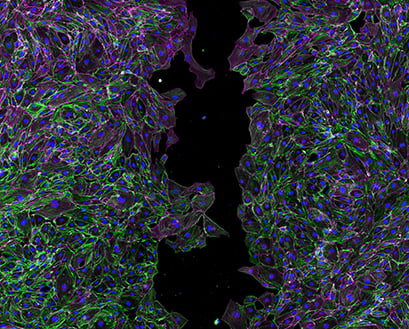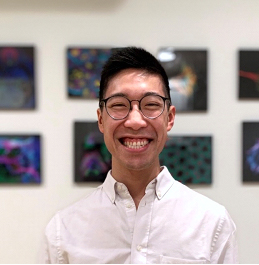Time Heals All Wounds
5 Reasons to Use the ibidi Culture Insert for Wound Healing and Migration Experiments
ibidi Blog | October 5, 2021 | Derek Sung, University of Pennsylvania School of Medicine
Cell motility and cell migration are some of the most commonly studied aspects of cell biology. To investigate mechanisms of cell migration, scientists traditionally turn to "scratch assays," which utilize a pipet tip to make a "scratch" down a monolayer of cells in a multi-well plate and observe the amount of time it takes for the gap to close (these are also sometimes appropriately called "wound closure" or "wound healing" assays). This type of experiment allows for analysis of cell migration and can be augmented with various drugs and chemicals to elucidate specific mechanisms.
 | Endothelial cells cultured in an ibidi 35mm µ-Dish with a 2-Well Culture-Insert. Cells were allowed to migrate for 24 hours after removal of the insert, then fixed in 4% PFA, and permeabilized. Cells were stained with an antibody against VE-cadherin (magenta), phalloidin for F-actin (green), and DAPI for nuclei (blue), and then subjected to confocal imaging. |
I've been performing scratch assays for as long as I can remember. Similar to most in vitro assays, consistency is key to achieving accurate and reproducible results. As someone who has performed this experiment countless times, using a pipet to manually create a gap has a few key issues that have given me trouble in the past. This is why discovering ibidi's Culture-Inserts was something of a lifesaver. The ibidi cell culture inserts have many advantages over traditional methods of scratch assays:
1. Consistent Gap Distance
One of the biggest challenges in traditional scratch assays and using a pipet to manually scratch down the center of the well to get rid of cells is inconsistency in gap distance. Moreover, the scratch itself is often not straight. As a result, the starting distance can often vary by tens to hundreds of microns. ibidi's cell culture inserts use a manufactured silicone insert that has a 500 µm distance. This ensures that the gap is straight and the distance is consistent every single time.
2. Clean Migrating Edge
A manual scratch also creates a problem of free-floating cells that were not entirely removed. These free-floating cells can affect the migration rate, either by delaying the migration of the free edge, releasing intracellular contents, or reattaching. ibidi's cell culture inserts are removable and leave behind clean margins and straight migrating edges .
3. Minimized Number of Cells
Traditional scratch assays are done in multi-well plates and require a confluent layer of cells. If the experiment has multiple conditions (drug treatment or genetic manipulation) and requires multiple replicates, this can quickly add up to a large number of cells. These experiments may become difficult to perform for precious or expensive cells (such as primary cells isolated from difficult-to-attain tissue). ibidi's cell culture inserts have a small growth area to minimize the number of cells required for an experiment (0.22 cm 2 per well, to be exact). This allows for maximum utilization of precious cells and/or increases the number of replicates.
4. Coverslip-Bottom Dishes
Scratch assays are typically done in multi-well plates with thick, polystyrene bottoms that only allow for brightfield imaging and quantification of the gap distance. ibidi's cell culture inserts have coverslip bottoms that are tissue culture treated and sterilized . This allows for brightfield and immunofluorescence imaging. Personally, I think this is the best aspect of the product and has allowed me to look at structures such as the cytoskeleton, cell-cell adhesion morphology, nuclear morphology, and more. Additionally, I can look at cells at the leading edge and compare them to lagging cells. Multi-modality imaging capabilities ultimately maximizes the amount of data from a single experiment, saving on costs and reagents.
5. Individual Inserts for Single Experiments
The "edge effect" refers to a cell culture phenomenon where wells in the outer perimeter of a multi-well plate experience more evaporation than inner wells, resulting in different conditions and potentially inconsistent results. Similar effects can be seen when conducting scratch assays using multi-well plates, affecting the consistency and reproducibility of results. ibidi's cell culture inserts are individually packed for single experiments . This prevents any "edge effects" and ensures consistent data. As a plus, the micro-dishes are designed with a lid-locking feature to ensure the lid stays on during handling the dishes.
Derek Sung — MD/PhD Student Derek is an MD/PhD student at the University of Pennsylvania School of Medicine, working in the fields of developmental and cell biology. His research investigates mechanisms of vascular development and he has an expertise in immunofluorescence staining and confocal microscopy. Check out his Instagram Channel @immunofluorescence . |
|
 (0)
(0)  (0)
(0)




